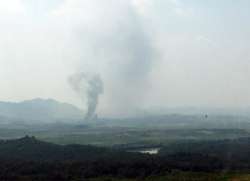North Korea blows up inter-Korean liaison office as tensions rise with S.Korea
North Korea blew up an inter-Korean liaison office building just north of the heavily armed border with South Korea on Tuesday in a dramatic display of anger that sharply raises tensions on the Korean Peninsula and puts pressure on Washington and Seoul amid deadlocked nuclear diplomacy.

North Korea blew up an inter-Korean liaison office building just north of the heavily armed border with South Korea on Tuesday in a dramatic display of anger that sharply raises tensions on the Korean Peninsula and puts pressure on Washington and Seoul amid deadlocked nuclear diplomacy.
The demolition of the building, which is located on North Korean territory and had no South Koreans working there, is largely symbolic. But it’s still likely the most provocative thing North Korea has done since it entered nuclear diplomacy in 2018 after a U.S.-North Korean standoff had many fearing war. It will pose a serious setback to the efforts of liberal South Korean President Moon Jae-in to restore inter-Korean engagement.
North Korea’s official Korean Central News Agency said the nation destroyed the office in a "terrific explosion" because its “enraged people” were determined to "force (the) human scum and those, who have sheltered the scum, to pay dearly for their crimes,” apparently referring to North Korean defectors who for years have floated anti-Pyongyang leaflets across the border.
The agency did not detail how the office in the North Korean border town of Kaesong was destroyed.
Photos from the South's Yonhap News Agency showed smoke rising from what appeared to be a complex of buildings. The agency said the area was part of a now-shuttered inter-Korean industrial park where the liaison office was located.
The North also said it has cut off all government and military communication channels with the South while threatening to abandon bilateral peace agreements reached during North Korean leader Kim Jong Un’s three summits with Moon in 2018.
Some outside analysts believe the North, after failing to get what it wants in nuclear talks, will turn to provocation to win outside concessions because its economy has likely worsened because of persistent U.S.-led sanctions and the coronavirus pandemic. North Korea may also be frustrated because the sanctions prevent Seoul from breaking away from Washington to resume joint economic projects with Pyongyang.
The liaison office has been shut since late January because of coronavirus concerns. The office, reportedly built with South Korean money, was the first such office between the two Koreas since their 1945 division and was considered a symbol of Moon’s engagement policy.
Seoul’s Blue House said presidential national security adviser Chung Eui-yong, who shuttled between Pyongyang and Washington to help set up Kim's first summit with President Donald Trump in June 2018, convened an emergency meeting of the National Security Council to discuss the North’s destruction of the liaison office. Details weren't immediately released.
North Korea had earlier threatened to demolish the office as it stepped up its fiery rhetoric over Seoul’s failure to stop activists from flying propaganda leaflets across the border.
On Saturday night, Kim Yo Jong, the influential sister of North Korea’s leader, warned that Seoul will soon witness “a tragic scene of the useless North-South liaison office (in North Korea) being completely collapsed.” She also said she would leave to North Korea’s military the right to take the next step of retaliation against South Korea.
The North has threatened to abandon a 2018 bilateral tension-reduction agreement, which observers say could allow the North to trigger clashes along the land and sea borders.
On Monday, Moon urged North Korea to stop raising animosities and return to talks, saying the two Koreas must not reverse the peace deals that he and Kim Jong Un reached during the 2018 summits.
North Korea has a history of taking highly visual symbolic steps. It invited foreign journalists to watch the detonation of its underground nuclear testing tunnels in 2018 and the demolition of a cooling tower at its main nuclear complex in 2008. Both events were an attempt by the North to show it was serious about denuclearization amid rampant outside skepticism about its commitment.
“It’s hard to see how such behavior will help the Kim regime get what it wants from the world, but clearly such images will be used for domestic propaganda,” said Leif-Eric Easley, a professor at Ewha University in Seoul.
Earlier Tuesday, North Korea’s military threatened to move back into zones that were demilitarized under inter-Korean peace agreements. The General Staff of the Korean People’s Army said it was reviewing a ruling party recommendation to advance into unspecified border areas that had been demilitarized under agreements with the South, which would “turn the front line into a fortress.”
Inter-Korean relations have been strained since the breakdown of a second summit between Kim and Trump in Vietnam in early 2019. That summit fell apart because of disputes over how much sanctions should be lifted in return for Kim’s dismantling his main nuclear complex.
In 2018, the rival Koreas opened their first liaison office at Kaesong to facilitate better communication and exchanges since they were divided into a U.S.-backed South Korea and a Soviet-supported North Korea at the end of the World War II in 1945. When the office opened, relations between the Koreas flourished after North Korea entered talks with South Korea and the United States on its nuclear weapons program.
Kim later vowed to expand his nuclear arsenal, introduce a new strategic weapon and overcome the U.S.-led sanctions that he said “stifles” his country’s economy.